

How to Grow and Care for Meyer Lemon Trees. Growing Meyer lemon trees in garden pots or the ground is a rewarding experience.
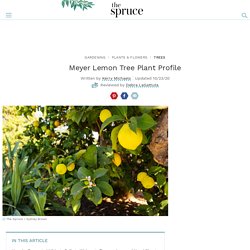
Not only are they prolific fruit producers, but their showy white blossoms are incredibly fragrant and beautiful. They also feature shiny dark green leaves. The Meyer lemon fruit is sweeter than the fruit of other lemons, and even the lemon peels are tasty and great for cooking. Although Meyer lemon trees are naturally shrub-like, they can also be pruned into tree form. When planted in the ground, they can grow to 10 feet tall. How To Grow Lavender. In the northern limit of its range, mulching Lavender plants in late fall will protect them from the winter's cold.
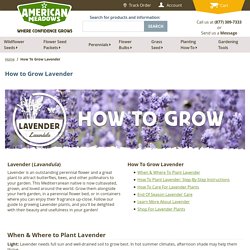
Pile wood chips or bark mulch on the plants after a freeze. This will insulate them from the cold, but not cause them to rot. Remove the mulch in early spring. Pests and Diseases: Pests & Diseases: Since lavender is very fragrant, many pests, such as deer and beetles, avoid this plant. Rhubarb: Planting, Growing, and Harvesting Rhubarb. How to Grow Hundreds of Ground Cherries - Tips for Planting Cape Gooseberries. Ground cherries (Physalis spp.), often called cape gooseberries, are native in many parts of the United States and often grow in fields and alongside roads.
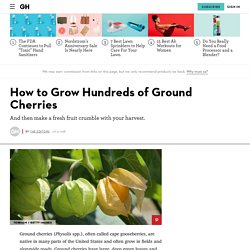
Ground cherries have large, deep green leaves and tons of pale yellow flowers that develop into cherry-sized fruits. To grow your own, start seeds of this frost-sensitive plant indoors six to eight weeks before the average last-frost date or buy transplants, which are increasingly available at nurseries and by mail order. Be sure to harden off seedlings before transplanting ground cherries outdoors.
Recommended Varieties of Ground Cherries Aunt Molly's: This Polish heirloom with a captivating citrus flavor takes 70 days to fruit.Pineapple: A popular variety with a distinct pineapple taste, this one takes 75 days to fruit and stores well in husks.Goldie: This variety also takes 75 days to produce masses of large, golden fruit. Planting Ground Cherries Ji Hyun Park / EyeEmGetty Images Common Ground Cherry Problems.
Pineapple sage, Salvia elegans – Master Gardener Program. Pineapple sage, Salvia elegans Salvia elegans is one of about 700 species in this genus in the mint family (Lamiaceae).
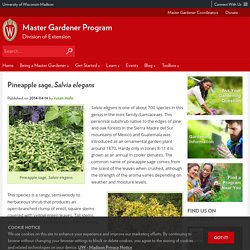
This perennial subshrub native to the edges of pine and oak forests in the Sierra Madre del Sur mountains of Mexico and Guatemala was introduced as an ornamental garden plant around 1870. Growing Artichokes: Learn How to Plant, Grow & Care for Artichokes. With long, silvery leaves and strikingly attractive blooms, the artichoke is a unique addition to your vegetable garden.

Growing artichokes isn’t difficult, and with the proper planting, watering and pruning, you can enjoy a bountiful harvest of edible chokes. What is an Artichoke? Many people think of thistles as prickly weeds, and no gardener wants a weed in their vegetable garden. But the artichoke, scientifically known as Cynara scolymus, proves that not all thistles are a nuisance. How to Grow Asparagus - Vegetables - Gardening Tips and Advice - Burpee. Can I Grow Asparagus?

Asparagus will grow well in virtually all areas of the US and lower Canada, except where there is extreme summer heat. For marginal areas where the lack of reliable freezing temperatures fail to initiate a dormancy rest period, withholding water in the winter can achieve a similar effect. Although asparagus favors a sandy loam soil, it is quite tolerant of all but the densest clays. As long as drainage is good and soil moisture can be maintained during the growing season, the asparagus plants will thrive. Tips for Sprouting Nasturtium Seeds. Quick-growing summer annuals can add nearly instant color to your garden beds and planters.
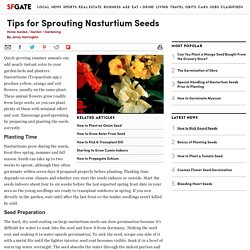
Nasturtiums (Tropaeolum spp.) produce yellow, orange and red flowers, usually on the same plant. These annual flowers grow readily from large seeds, so you can plant plenty of them with minimal effort and cost. Encourage good sprouting by preparing and planting the seeds correctly. How to Grow Beets - Tips for Planting Beets. High in fiber and rich in vitamins A and C, beets have more iron than other vegetables, including spinach.
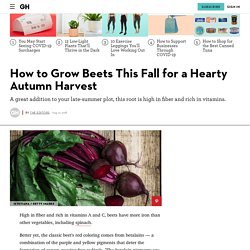
Better yet, the classic beet's red coloring comes from betalains — a combination of the purple and yellow pigments that deter the formation of cancer-causing free radicals. "The betalain pigments are potent antioxidants," says Irwin Goldman, Ph.D., a beet geneticist at the University of Wisconsin at Madison. How to Propagate Lemon Verbena. Lemon verbena (Aloysia triphylla), a small species of perennial shrub, is grown for its slender, fragrant foliage and dainty flower clusters, which add ornamental appeal in the summer.

It grows in U.S. Department of Agriculture plant hardiness zones 8 to 10, where it will reach a mature height of 1 to 3 feet with an 18-inch spread. Information On Rosemary Plant Propagation. The piney scent of a rosemary plant is a favorite of many gardeners.
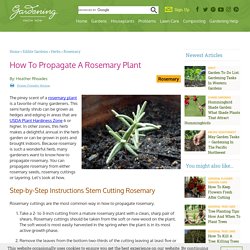
This semi hardy shrub can be grown as hedges and edging in areas that are USDA Plant Hardiness Zone 6 or higher. In other zones, this herb makes a delightful annual in the herb garden or can be grown in pots and brought indoors. Because rosemary is such a wonderful herb, many gardeners want to know how to propagate rosemary.
You can propagate rosemary from either rosemary seeds, rosemary cuttings or layering. Let’s look at how. Step-by-Step Instructions Stem Cutting Rosemary. Pumpkins: Planting, Growing, and Harvesting Pumpkins. Growing conditions for edible canna. How to Grow Turmeric in Pots - Plant Instructions. How to grow turmeric. How to Grow Pomegranates in Oregon. Pomegranate image by Ergün Özsoy from <a href=' The pomegranate tree grows well in Oregon home gardens in the western half of the state where the USDA hardiness zones are 7 through 9. The pomegranate tree will not tolerate temperatures that fall below 10 degrees F.
Pomegranate trees require little maintenance once the tree becomes productive after three years of growth. The tree will produce fruit for up to 15 years after planting when given adequate care and water. Choose a planting location for the pomegranate tree that has well-draining soil and bright sunlight for a minimum of eight hours each day. Test the soil pH prior to planting as pomegranate trees grow best in an acidic soil of 5.5 to 7.0. Plant the pomegranate tree in a hole that is the same depth and twice as wide as the root ball of the tree. Coe's Comfrey. Originating in the Caucasus mountains of Russia, Comfrey can withstand temperatures of -40° F below zero without winter kill. It thrives in Africa in 120° F heat and with 12 cuttings per year there, they hold the world record yield of over 140 tons per acre.
Comfrey can be planted spring, summer or fall, anytime the soil can be worked. In warmer climates (Deep South and Southwest USA), it can be planted and the leaves harvested throughout the year. If You Can Grow Basil, You’ll Have No Troubles With Shiso. Shiso (Perilla frutescens) is known in some circles as Japanese basil. And like basil, it is easy to grow in Hawaii any time of the year. For the lucky soul who has shiso in the garden there are many uses for the leaves, the flowers and the seeds.
Description. Growing fennel — bulb, herb, pollen - Growing for Market. By Pam Dawling Many people grow fennel as the herb, for leaves and seeds, for salads, soups, fish dishes and teas. The seeds are also used in desserts, breads, other baked goods and drinks. Or they are chewed after a meal to help the digestion. A newer crop in the U.S. is bulb fennel, with a vaguely licorice-like flavor. The crunchy white “bulb” consists of the swollen stem bases of the leaves.
Cultivating Edible Mushrooms with Dave Wichland. MushroomCultivationGuide. How To Grow Ginger Root - Planting Ginger Plant In Your Herb Garden. Fig Tree Fertilizer – When And How To Fertilize A Fig Tree. By Jackie Carroll One thing that makes fig trees so easy to grow is that they rarely need fertilizer.
In fact, giving a fig tree fertilizer when it doesn’t need it can harm the tree. A fig tree that gets too much nitrogen produces less fruit and is more susceptible to cold weather damage. Growing Turmeric in Containers. Harvesting Leeks and Onions (5/21/11) Leeks: How to Plant, Grow, and Harvest. The Rhubarb Compendium. Rhubarb is a cool season, perennial plant that is very winter hardy and resistant to drought.
Its crop is produced from crowns consisting of fleshy rhizomes and buds. Following a season of growth the rhubarb crown becomes dormant and temperatures below 40 °F / 5 °C are required to stimulate bud break and subsequent growth. How to Grow Ginger. Planting, Growing & Harvesting Broccoli.